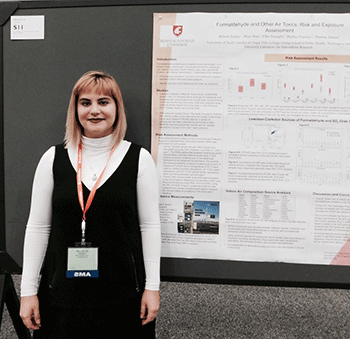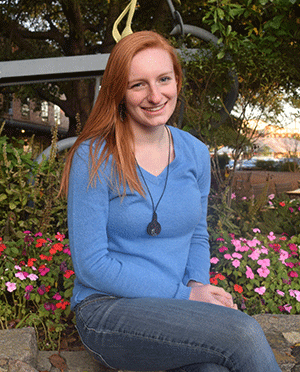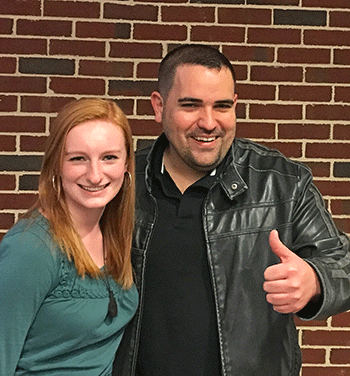Gillings School undergraduates who will change the world
Highlighting the work of Sarah Zelasky and Allison Eames
January 16, 2018
Two Bachelor of Science in Public Health students in environmental sciences and engineering at the UNC Gillings School of Global Public Health have made great use of the National Science Foundation-funded Summer Research Experience for Undergraduates program.
As participants in the highly competitive program, Sarah Zelasky and Allison Eames were involved in meaningful ways during summer 2017 in ongoing research projects at major universities in the U.S.
According to their adviser, Jason Surratt, PhD, associate professor of environmental sciences and engineering at the Gillings School and co-director of undergraduate studies in the department, both are poised to make important contributions to the field for many years to come.
Zelasky, a native of Raleigh, N.C., was introduced to the Gillings School as a junior in high school, when she toured the Environmental Protection Agency in Research Triangle Park, N.C. Jacky Rosati, PhD, an adjunct professor at the Gillings School and chief of the Air Pollution Technology Branch in EPA’s National Risk Management Research Laboratory, recommended the Gillings School’s Bachelor of Science in Public Health degree in environmental health. Zelasky decided the courses aligned well with her interests.
“My life would be very different if I had not chosen to come to the Gillings School,” Zelasky said.
When I began taking coursework in the School as a junior, I immediately felt welcomed into a close-knit network of advisers, faculty members, graduate students and peers; I could not imagine a more helpful support system.
My professors and advisers are extremely approachable and encouraging. They’ve been available to chat in their offices and have definitely helped me figure out my interests and career goals, and have assisted me in internship, fellowship and graduate school applications.
In fall 2018, she will be pursuing a master’s program at one of the several places she has been accepted.
“Sarah is an excellent example of the high-quality undergraduate students with whom we work in our department,” said Surratt. “In addition to her strong academic performance, she has contributed to research projects in atmospheric chemistry at UNC and at a summer Research Experience for Undergraduates at Colorado State University (CSU).”
Surratt noted that Gillings School environmental sciences and engineering students are well-prepared to compete for admission into prestigious programs such as the one at CSU.
“Working with Dr. Jeffrey Pierce at CSU,” Surratt said, “Sarah was able to contribute some mortality estimates derived from exposure to wildfire smoke in the U.S. She was excited to find that her work was featured recently in The Washington Post. Climate change is increasing the incidence of wildfires throughout the U.S. and the world. Sarah’s high-quality research was featured in the news article as evidence that elevated exposures to adverse air pollutants (such as from the wildfires) will rise in the future.”
“Waking up to an email from Dr. Pierce, my principal investigator (PI), who had sent links to my research in The Washington Post and Axios, seemed so surreal,” Zelasky said.
When I spent my summer modeling the future health impacts of wildfire smoke at Colorado State’s Research Experience for Undergraduates, I’d assumed my findings would only be preliminary to future work done in the lab.
It was only when my PI asked me to look over a poster being submitted to the American Geophysical Union conference in New Orleans that I realized he’d chosen to include the results I produced in my health impact assessment and credit me as an author! In fact, out of the six sections on the poster, two were entirely my results, mortality estimates and visuals – and the sections on mortality were the headlines in the news articles!
It is a dream as a scientist to have your work recognized as important and influential, so seeing it featured in a major national newspaper was unbelievable so early in my career.
Although the initial part of my REU project – calculating projected PM2.5 concentrations – was of interest to me, the health impact assessment at the end of my research was my favorite part because it related hard science findings to human health and highlighted the importance of the problem at hand, where it occurs, and who it affects.
In other words, I realized that I was not interested in specific measurements and mechanisms, but rather in looking at the ‘big picture’ of hazardous environmental exposures and potential consequences.
In fall 2017, Zelasky worked with Andrew George, PhD, research associate and lecturer at the UNC Institute for the Environment, on a capstone project on well-water contamination. Her team analyzed 4,000 rural, private well-water tests from a public database and analyzed the dataset for possible correlations between unsafe levels of arsenic, lead, and manganese and socioeconomic factors.
In spring 2018, she is volunteering in the lab of Jacqueline MacDonald Gibson, PhD, associate professor of environmental sciences and engineering, on a similar project – studying minority children’s exposure to lead by way of drinking water from private wells.
Zelasky said that after completing graduate study, she will be ready to get to work as an environmental consultant or an investigator at a research institute.
“Eventually, I hope my work will become influential in advising policy makers to protect human and environmental health,” she said. “I have a strong belief that things that are good for the environment are also good for human health and for the long-term economy. I love the intersection between multiple disciplines such as these and hope that my work can lead to solutions that solve more than one problem at a time.”

Allison Eames poses with her research poster at the American Meteorological Society conference in Austin in 2017.
Allison Eames, a native of Roswell, Ga., had wanted to come to UNC since she visited as a high school sophomore. She had planned to study chemistry but became inspired when she learned about the environmental health sciences degree.
“Since beginning at the Gillings School, I’ve learned from so many excellent professors,” Eames said.
An environmental chemistry course with Surratt developed her interest in atmospheric chemistry, which led her to apply to the REU program at Washington State University, in the university’s Laboratory for Atmospheric Research.
“I conducted research on formaldehyde in the Lewiston-Clarkston Valley,” Eames described.
We did field measurements in three sites there, gathering all kinds of meteorological and chemical data as a follow up to an Environmental Protection Agency study that found high levels of formaldehyde in the area.
The Nez Perce tribe in Idaho was concerned with health effects from exposure, so we worked with them to help identify the source of formaldehyde, and I helped characterize the risks associated with exposure. I performed risk assessment on cancer and noncancer endpoints and compared them to formaldehyde exposure in the home.
One major finding was that formaldehyde risk is much higher in the home (on the order of 200-1000 excess cancers per million) as compared to the valley (20-50 excess cancers). We also added evidence to the theory that formaldehyde pollution was coming from the pulp and paper mill.
“Allison had a very successful experience at the Washington State REU in summer 2017,” Surratt said. “In early January 2018, she presented her findings at the American Meteorological Society (AMS) conference in Austin. She’s another shining example of how our talented undergraduates apply their knowledge to research questions outside UNC.”
“Presenting at the AMS was a great experience because it was my first conference, and I gained valuable experience in science communication,” Eames said. “In the future, I hope to pursue an MD/PhD degree and continue working on health disparities issues.”
Surratt noted that the REU programs were competitive and hard to get into.
“The fact that our students are getting into these programs is definitely a good sign,” he said.
Share
Gillings School of Global Public Health contact: David Pesci, director of communications, (919) 962-2600 or dpesci@unc.edu


